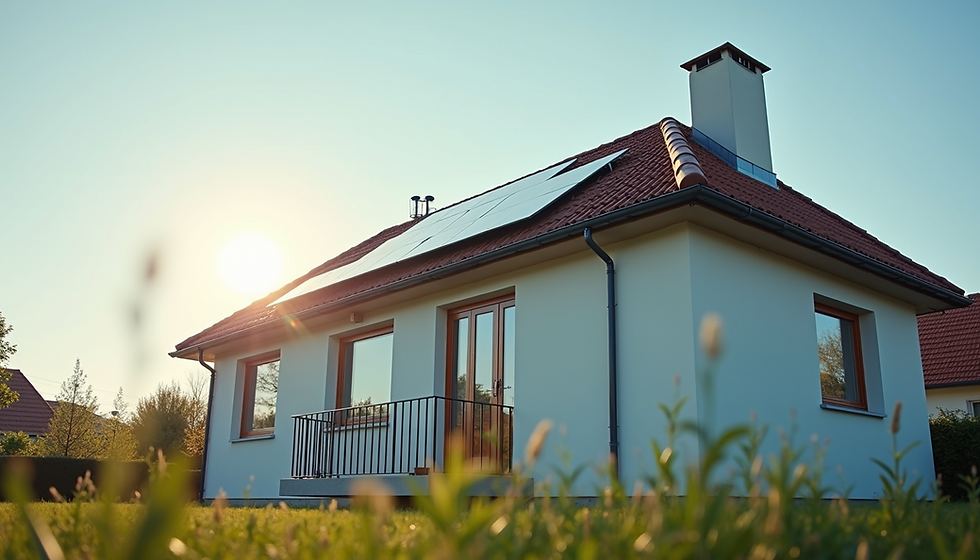Comprehensive Guide to SAP Energy Assessments
- Justin Barker
- Oct 28
- 4 min read
Updated: Nov 17
When planning a new build or extension, understanding your project’s energy performance is essential — not just for meeting Building Regulations, but for reducing long-term running costs and environmental impact.
This is where a SAP Energy Assessment comes in. A SAP (Standard Assessment Procedure) calculation provides a detailed evaluation of how efficiently a dwelling uses energy. It helps ensure compliance, promotes sustainable design, and identifies opportunities to improve energy efficiency from the start.
What Is a SAP Energy Assessment?
SAP stands for Standard Assessment Procedure, the UK Government’s official method for measuring and comparing the energy and environmental performance of new homes and certain conversions or extensions.
The assessment calculates energy use and carbon emissions by analysing factors such as:
Insulation levels
Heating and hot water systems
Ventilation methods
Fuel types
Renewable technologies
The outcome is a SAP rating — a numerical score between 1 and 100+. The higher the score, the more energy-efficient the dwelling. This figure gives builders, architects, and homeowners a clear benchmark for compliance and improvement.
Key Components of a SAP Assessment
A SAP assessment examines every aspect that affects a building’s energy use and heat loss. Key components include:
Building Fabric – The insulation quality of walls, floors, roofs, windows, and doors.
Heating Systems – Efficiency and controls for space and water heating.
Ventilation – Air movement and its impact on heat retention.
Renewable Technologies – Solar panels, air/ground source heat pumps, or other low-carbon systems.
Fuel Types – The kind of energy used for heating and power generation.
By analysing these, a SAP assessor can provide a full picture of the property’s energy efficiency and carbon footprint.

Why SAP Energy Assessments Matter
1. Compliance with Building Regulations
SAP calculations are a mandatory requirement under Part L of the Building Regulations (Conservation of Fuel and Power). Without a valid SAP report, you cannot demonstrate compliance or obtain a Building Control sign-off.
2. Reduced Energy Costs
A SAP report highlights where energy efficiency can be improved. Implementing its recommendations — such as better insulation, efficient boilers, or renewables — can substantially cut heating and electricity costs.
3. Sustainability and Carbon Reduction
SAP encourages sustainable construction by identifying carbon-saving opportunities, helping the UK move closer to its net-zero targets.
4. Added Market Value
Energy-efficient homes are increasingly desirable. A good SAP score can enhance comfort, reduce bills, and boost resale value — all appealing to modern buyers.
SAP vs EPC — What’s the Difference?
It’s common to confuse SAP assessments with Energy Performance Certificates (EPCs), but they serve different purposes and happen at different stages.
SAP Assessment | EPC | |
When Conducted | During the design stage (before or during/after construction) | Only after construction is complete |
Purpose | To demonstrate compliance with Building Regulations Part L | To show overall efficiency when selling or renting |
Output | SAP score and compliance report | Lodged Energy Performance Certificate for the finished property |
In short: SAP calculations always come first, providing the foundation for the final EPC once the build is completed.

Preparing for a SAP Assessment
Good preparation ensures an accurate and smooth assessment process. You’ll need to provide your SAP assessor with:
Architectural drawings – Floor plans, elevations, and sections.
Construction details – Materials for walls, floors, roofs, windows, and doors.
Heating and ventilation specifications – Including system types, efficiency data, and controls.
Renewable technologies – Information about any solar panels, heat pumps, or other systems.
Site access – To allow inspection and verification where required.
Engaging your SAP assessor early in the design stage helps identify potential compliance issues before construction begins — saving time, money, and redesigns later.
How to Use SAP Results Effectively
Your SAP report doesn’t just confirm compliance — it provides valuable insights you can use to optimise performance.
Typical Rating Scale:
80–100+ – Excellent efficiency
60–79 – Good; some improvement possible
Below 60 – Considerable improvements needed
Common recommendations include:
Upgrading insulation and glazing
Installing efficient boilers or heat pumps
Using smart heating controls
Adding renewable technologies
Improving ventilation balance
Builders and designers can use these findings to fine-tune specifications and achieve better results for both the environment and the homeowner.
Choosing a Professional SAP Assessor
Always use an accredited SAP assessor familiar with current Part L regulations and local authority requirements. Working with an experienced provider ensures accurate calculations and full compliance documentation — from Design SAP Calculations through to As-Built SAP Certificates.
At sap2sbem.co.uk, we provide professional SAP and SBEM assessments for new builds, extensions, and conversions across the UK. Our expert team can help you navigate compliance, improve your project’s efficiency, and achieve the best possible rating.
Final Thoughts
Understanding and implementing SAP Energy Assessments early in your project is one of the most effective ways to ensure compliance, control costs, and build sustainably.
With the right guidance and accurate calculations, you’ll be creating homes that are not only compliant — but comfortable, cost-effective, and built for the future.
Contact our SAP2SBEM team today for accurate SAP or SBEM assessments for your project.



Comments